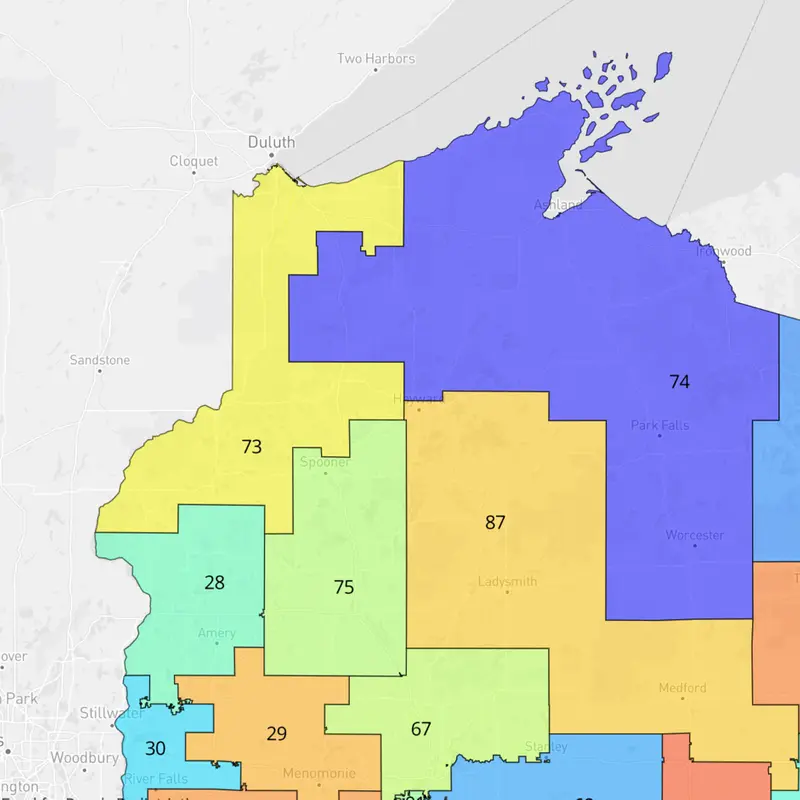Wisconsin Picks New Legislative Maps That Would End Years of GOP Gerrymandering
After we wrote about a suspected cartel donation to the Mexican president’s 2006 campaign, he’s gone on the attack against reporter Tim Golden. Golden won’t be attending AMLO’s press conferences, but here, we respond to some of his questions.

Wisconsin’s dinosaur-shaped legislative district could soon be history.
The curiously drawn district and other oddities associated with the state’s extreme gerrymandering would be erased in new voting maps passed this week by the Wisconsin Legislature.
A state Supreme Court decision finally forced Wisconsin Republicans to cede an advantage they enjoyed for more than a decade with maps that made the state one of the nation’s foremost examples of gerrymandering.
The Senate and Assembly voted to adopt voting maps drawn by the office of Gov. Tony Evers, a Democrat. Evers said a week ago that he would sign his redistricting plan into law if passed unchanged by the Legislature, and proponents of fairer maps have encouraged him to do so.
The surprising legislative development promises to end a six-month battle in front of the state’s now left-leaning high court, which ruled the GOP maps unconstitutional shortly before Christmas.
The new design resolves many of the irregularities in the current electoral maps, chief among them the “Swiss cheese” appearance that stranded some constituents in segments detached from the rest of their districts.
One of the more obvious examples of partisan artifice was in the northwest corner of the state, in the 73rd Assembly District, where the GOP had strategically added Republican areas and subtracted Democratic ones in a plan enacted in 2022. Residents joked the contours came to resemble a Tyrannosaurus rex.
The maneuver was successful. That year, a Republican won the seat, which had been held by Democrats for 50 years. The new map completely redraws that district and others.
“The legislature will be up for grabs,” Republican Assembly Speaker Robin Vos said from the floor on Tuesday, the day the vote was taken.
In an unusually magnanimous gesture, Vos said, “Pains me to say it, but Gov. Evers gets a huge win today.”

Even under the governor’s maps, the GOP is still expected to retain majorities in both chambers, though the party’s advantage would likely be slimmer than the absolute authority it now commands, particularly in the Senate. Currently, the GOP has a supermajority in the Senate and a near supermajority in the Assembly.
Vos acknowledged in a news conference that running under Evers’ map is “going to be more challenging, there’s no doubt about that.” But, he said, “I still think we can win because we have a better message.”
Prior to the legislative action, justices had been set to select new district maps from a group of proposals, including the one from Evers. Indications were the decision would not be favorable to the GOP.
Rather than take their chances, Republicans decided to approve the governor’s maps, which are considered to be “friendlier” to the GOP than the others when measuring partisan bias and incumbent matchups.
A Marquette University analysis determined that if the 2022 election had taken place under Evers’ maps, it’s likely that Democrats would have won an additional 11 seats in the Assembly and five in the Senate, neither enough to flip control.
Nine Senate Democrats voted against Evers’ plan, signaling concerns that the GOP’s approval was a strategic ploy to be followed by a challenge in federal court from a Republican ally. “I am voting no because I do not trust what you guys are up to,” said Sen. Chris Larson, a Milwaukee Democrat.
But Vos downplayed the likelihood of more court action, telling reporters Tuesday that he preferred to get on with the business of campaigning and talking about ideas with voters. “I think that is a better answer than drawn-out court battles and going through millions of dollars of taxpayer expense when there’s really no need to do so,” he said.
The Assembly passed the governor’s maps without debate. Only one Democrat voted yes.
Democrats were unhappy with a provision in the bill that would stall the implementation of the new maps until November — a move seen to benefit Vos, who is facing a recall effort from constituents on the far right. Democrats also indicated a desire to let the state Supreme Court case play out.
It was only six months ago that a new justice, Janet Protasiewicz, took office, tilting the court decidedly to the left. During her campaign, which she won in a landslide, she made it clear she would welcome the chance to review the constitutionality of the maps, flatly describing them as “rigged.”
A day after her swearing-in ceremony, a maps case landed on the court’s doorstep, brought by 19 Democratic voters. For months after Protasiewicz’s election, Vos threatened to impeach her if she did not recuse herself from the case, claiming her remarks on the campaign trail made her biased. He later abandoned that tactic.
On Dec. 22, the high court overturned the current maps and ordered the parties to propose new ones. The vote on the decision was 4-3, with Protasiewicz siding with the majority.
The court hired two academic consultants to analyze the proposals and issue a report evaluating the plans for their conformity to standard districting requirements, including compactness and equal population distribution.
The consultants found that plans offered by GOP lawmakers and by a conservative policy group constituted “partisan gerrymanders” and should not be considered.
The four remaining proposals greenlit by the consultants were submitted by the plaintiffs, Evers’ office, a group of Democratic senators, and a team of mathematicians and data scientists. The consultants — from Carnegie Mellon University in Pittsburgh and the University of California, Irvine — determined that those four plans were “similar on most criteria.”
Good-government groups applauded the possibility of a legislative agreement, largely because it brings about stability and a measure of political certainty until the next redistricting process, after the 2030 census. Besides, said Jay Heck, executive director of Common Cause Wisconsin, “The governor’s maps are pretty darn good.”
One of the key problems with the current maps, the court concluded, was that the districts had noncontiguous shapes.
The state’s constitution stipulates that Assembly members must be elected from districts consisting of “contiguous territory.” Likewise, Senate districts, which are each made up of three Assembly districts, must consist of “convenient contiguous territory.”
Fifty-five of the state’s 99 Assembly districts and 21 of 33 Senate districts contained “disconnected pieces of territory,” according to the petition presented to the Supreme Court.
“A map can’t be fair if it doesn’t meet the requirements of the constitution,” said Debbie Patel, founder of North Shore Fair Maps, a group of suburban Milwaukee residents who have been fighting for statewide maps that are not skewed in favor of either party.
The random islands or irregular blobs in the current maps are largely due to the annexation of land over time by cities and villages, resulting in disjointed municipal boundaries.
The Evers maps and the others under consideration fix that problem.
The 88th Assembly District, for example, which currently includes eastern portions of Green Bay, has a couple of islands and a hole that would be eliminated under Evers’ plan.
The district’s current occupant, Republican Rep. John Macco, voted yes Tuesday, even though his home would no longer be within the district’s boundaries. “They literally carved me out by 581 feet. Intentionally,” he said.
He expects to have to sell his house and move to compete again there. “I’ll do whatever I have to do to represent the people of the 88th District,” he said in an interview.
In northwest Wisconsin, Democrats hope they can reclaim the 73rd District under a new map. All four maps under court consideration relegate the “T. rex” to fossil status.
Under Evers’ iteration, the district would no longer stretch more than 100 miles south from the Minnesota border city of Superior. Instead, it would be more homogeneous, encompassing much of Douglas County, and reach farther east, embracing more of the coastal communities along Lake Superior.


“Historically, you’ll see from voting records, it’s always been blue up here right along the lake,” said Laura Gapske, a Democrat who narrowly lost in 2022 to the district’s current representative, Republican Angie Sapik. Gapske handily carried Douglas County, with 58% of the vote. She’s now running for the Superior School Board.
Sapik, who wrote social media posts cheering on the Jan. 6 insurrectionists, has announced her reelection bid. She declined to speak to ProPublica but complained on Facebook in early February that the proposed maps “would make this district upwards of 65% Dem to 35% Republican. Does that sound like a ‘Fair Map’ to you?”
One area where the four maps differed was in how they handled redistricting for territories aligned with Wisconsin’s federally recognized Native American tribes.
The current GOP map divides four of 10 reservations into multiple Assembly districts, “disrespecting Tribal communities of interest,” according to a brief filed by the Midwest Alliance of Sovereign Tribes and the Lac du Flambeau tribe in Wisconsin. Lawyers for the tribes have argued that dividing tribal members among different districts dilutes their voting power.
The Lac du Flambeau tribe and the Midwest Alliance did not favor the governor’s plan, supporting instead a proposal put forward by the group of mathematicians, in which each tribe would have had its own Assembly voting district.
In its brief, the alliance called the mathematicians’ proposal “hands down, the best map for all of Wisconsin, including Wisconsin’s Indian people and communities.”
A spokesperson for Evers told ProPublica in an email that “the governor’s maps do unite tribal communities in several respects while still complying with constitutionally required criteria to minimize splitting community and county lines.”
The Wisconsin Fair Maps Coalition, while celebrating the prospect of new maps, is vowing to continue to push for a nonpartisan body, rather than politicians, to handle future redistricting plans.
“The coalition isn’t done,” said Debra Cronmiller, executive director of the League of Women Voters of Wisconsin, which is part of the coalition. “We still need a legislative fix. We need an independent commission. We need, likely, a constitutional amendment that would codify that. So our work is not done.”
ProPublica is a nonprofit newsroom that investigates abuses of power. Sign up for Dispatches, a newsletter that spotlights wrongdoing around the country, to receive our stories in your inbox every week.
ProPublica is a nonprofit newsroom that investigates abuses of power. Sign up for Dispatches, a newsletter that spotlights wrongdoing around the country, to receive our stories in your inbox every week.






